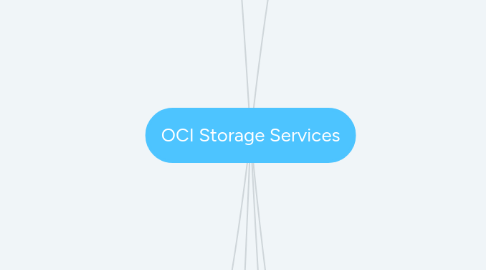
1. Block Volumes
1.1. Volumes Size
1.1.1. 50 GB - 32 TB
1.2. Attach up
1.2.1. 32 Volumes/instance
1.2.1.1. 1 PB
1.3. Encrypted
1.3.1. Oracle managed
1.3.2. Customer managed keys
1.3.3. At Rest
1.3.4. In-transint
1.4. What is Block Storage?
1.4.1. Hard drive in server
1.4.1.1. Remote Chassis
1.4.2. Fixes sized blocks
1.4.2.1. Eg. 512 Bytes
1.4.3. Accessed by OS
1.4.3.1. Mounted Drive Volume
1.4.4. Applications/file systems
1.4.5. Data o Stored wihtout any higher-lever metada
1.4.5.1. For data format
1.4.5.2. Type
1.4.5.3. ownership
1.4.6. Any kind of FS on Block Volumes
1.4.6.1. Windows
1.4.6.1.1. NTFS
1.4.6.2. Vware
1.4.6.2.1. VMFS
1.5. Storage for Compute Insrances
1.5.1. Remote
1.6. 2 Types
1.6.1. Boot Volumes
1.6.1.1. OS Disk
1.6.2. Block volumes
1.6.2.1. Data Disk
1.7. Why do use?
1.7.1. Service lets you store data
1.7.1.1. Independently
1.7.1.2. beyond the lifespan of CI
1.8. Uses Cases:
1.8.1. Databases
1.8.2. Exchange
1.8.3. VMware
1.8.4. Server Boot
1.9. Highly Durable
1.9.1. Storage is highly durable
1.9.2. Persistent
1.9.3. Store Replicas of data
1.9.3.1. 3 separate FD
1.9.4. Don't need to Configure any software based protection
1.9.4.1. RAID-10 etc
1.9.5. To minimize loss of data due to deletes or corruption
1.9.5.1. THE USER MAKE
1.9.5.1.1. PERIODIC BACKUPS OF BLOCK VOLUMES
1.9.5.1.2. AUTOMATED
1.10. Backup
1.10.1. Complete point-in-time snapshot copy of your block volumes
1.10.2. Encrypted and stories in the Object Storage
1.10.2.1. Restored a New volumes to any AD WITHIN the Same Regions
1.10.2.1.1. For multi-AD region
1.10.3. Copy block Volumes backups
1.10.3.1. From one-region to another
1.10.4. Scheduled
1.11. Tiers
1.11.1. Basic
1.11.1.1. Use
1.11.1.1.1. Workloads that are throughput
1.11.1.2. IOPS
1.11.1.2.1. 2 IOPS/GB
1.11.1.3. Throughpu
1.11.1.3.1. 240 KB/s/GB
1.11.2. Balanced
1.11.2.1. Use
1.11.2.1.1. Workloads
1.11.2.2. IOPS
1.11.2.2.1. 60 IOPS/GB
1.11.2.3. Throughput
1.11.2.3.1. 480 KB/s/GB
1.11.3. Higher Performance
1.11.3.1. Use
1.11.3.1.1. Most IO-Demanding workloads
1.11.3.2. IOPS
1.11.3.2.1. 75 IOPS/GB
1.11.3.3. Throughput
1.11.3.3.1. 600 KB/s/GB
2. Local NVMe
2.1. Tempprary NVMe
2.1.1. Attached to the compute instance
2.2. Designed for applications require High-performance local sotrage
2.3. Uses Cases:
2.3.1. NoSQL
2.3.2. In-memory Databases
2.3.3. Scale-out transaction databases
2.3.4. Data warehousing
2.4. Storage is no-persistent
2.4.1. Survives reboot
2.5. OCI uses NVMe
2.5.1. Non-Volatile Memory Express
2.6. OCI NO Provider
2.6.1. RAID
2.6.2. Snapshots
2.6.3. backups
2.7. Customer Are responsible for data durability
2.8. Block based Protocol (Like Block Volume)
2.9. SLA
2.9.1. Performance
3. File Storage
3.1. Hierarchical Collection os Documents
3.1.1. Organized into
3.1.1.1. Name
3.1.1.2. Directories
3.2. Distributed FS
3.2.1. Exactly like local fs
3.3. Distributed File Standards
3.3.1. NFS/SMB
3.3.1.1. Unix/Windows
3.3.2. Allow
3.3.2.1. Creation
3.3.2.2. Deletion
3.3.2.3. Reading
3.3.2.4. writing
3.3.2.5. sharing
3.3.2.6. Locking
3.3.3. Supported
3.3.3.1. Oses
3.3.3.2. Hypervisor
3.3.4. (Typically) no extra client software
3.3.5. Provide access over Networks
3.4. Shared FS Storage
3.4.1. For Compute Instance
3.5. Supports NFS
3.5.1. V3
3.6. Data Protection
3.6.1. Snapshots
3.6.1.1. 10.000 snapshots per FS
3.7. Encryption
3.7.1. Data-at- rest
3.7.2. In-transit
3.7.3. File system & Metadata
3.8. Use cases:
3.8.1. Oracle aplications
3.8.1.1. EBS
3.8.2. HPC
3.8.3. Big Data and Analytics
3.8.4. General Purpose FS
3.9. Highly Durable
3.9.1. Storage is High durable and persistent
3.9.2. Replicas in 3 FD
3.9.3. You Take Snapshots that provide
3.9.3.1. Read-Only
3.9.3.2. Space- efficient
3.9.3.3. Point-in-time backup
3.9.4. You can restore a file within the snapshot
3.9.4.1. Using Command
3.9.4.1.1. CP
3.9.4.1.2. rsync
4. Object Storage
4.1. What is Object Storage?
4.1.1. All data regardless of content type is managed as Object
4.1.2. Each Object stored in a Bucket
4.1.2.1. Bucket
4.1.2.1.1. Is a logical container for Storing object
4.1.3. Objects ar stored in a single, flat structure
4.1.3.1. Without a folder hierarchy
4.1.3.1.1. Accessing individual objects is fast and easy
4.1.4. Each Object is composed
4.1.4.1. Object itsel
4.1.4.1.1. Metadata of the object
4.1.5. Very high
4.1.5.1. Scalability
4.1.5.2. Reliability
4.1.6. Relies on Standard
4.1.6.1. HTTP Verbs
4.2. High-performance storage platform
4.3. Unlimited amount of unstructured data
4.3.1. Images
4.3.2. Media
4.3.3. Files
4.3.4. Logs
4.3.5. Backups
4.4. Regional Services
4.4.1. Not tied to any specific Compute Instance
4.5. Two distinct Storage Classes
4.5.1. Hot Storage (Standard)
4.5.2. Cold Storage (Archive)
4.6. Uses Cases:
4.6.1. Content Repository for data
4.6.1.1. Images
4.6.1.2. Logs
4.6.1.3. Videos
4.6.1.4. etc
4.6.2. Archive/Backup
4.6.2.1. For long period of Times
4.6.3. Storing Log Data
4.6.3.1. For Analysis
4.6.3.2. Debugs
4.6.3.3. Troubleshoonting
4.6.4. Big Data
4.6.5. Hadoop Storage
4.7. Highly durable
4.7.1. Replicas
4.7.1.1. 3 Separate FD in AD
4.7.2. In a multi-Ad region
4.7.3. Data integrity
4.7.4. Actively Monitored
4.7.4.1. Corrupt
4.7.5. Auto Reapired
4.7.6. Cross-region copy DR
4.8. Tiers
4.8.1. Standard Storage (HOT)
4.8.1.1. Fast
4.8.1.2. Immediate
4.8.1.3. Frequent access
4.8.1.4. Data retrieval is instantaneous
4.8.1.4.1. Most recent copy of de data
4.8.1.5. Standard Buckets Cam't be downgraded to Archive Storage
4.8.2. Archive Storage (Cold)
4.8.2.1. Rarely accessed data
4.8.2.2. Preserve for long period os time
4.8.2.3. 10 X cheaper than standard
4.8.2.3.1. ($0.0026 v/s $ 0.0255 Gb/month)
4.8.2.4. Minimal Retention
4.8.2.4.1. Requirement 90 days
4.8.2.5. Objects need to be restored restored before download
4.8.2.5.1. Time To First Byte (TTFB)
4.8.2.6. Archive Bucket Can't be Upgraded to Standard Storage tier
5. Storage Requirements
5.1. Persistent v/s non persistent
5.2. Type of Data
5.2.1. Database
5.2.2. Videos
5.2.3. Audio
5.2.4. Photo
5.2.5. text
5.3. Performance
5.3.1. Max Capacity
5.3.2. IOPS
5.3.3. Thoughput
5.4. Durability
5.4.1. Of Copies of Data
5.5. Connectivity
5.5.1. Local v/s network
5.5.2. How does app Access the data
5.6. Protocol
5.6.1. Block
5.6.2. File
5.6.3. Https
